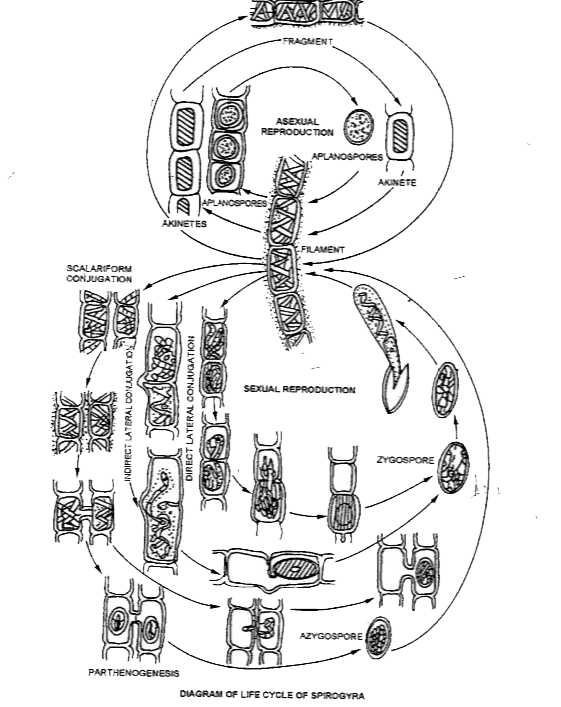Describe occurrence, cell structure and life cycle of spirogyra.
Text Solution
Occurrence. It is a cosmopolitan, fresh water, olive-green, filamentous alga. The spirogyra looks like a mass of shining long filaments, hence it is known as "Pond silk. or .Water silk.. It is found growing abundantly on the surface of stagnant ponds. Structure. Spirogyra filaments are unbranched. Their cells unite together in a line end to end. All cells are alike, but in the species, found in running water the filaments attach to substrate with the help - of unicellular, colourless hapteron. The cells are rectangular. The transverse wall, -separating two adjoining cells, has a middle lamella. Each cell is surrounded by a two layered cell wall. Its inner layer is made up of cellulose and the outer layer is made up of pectose. The outer part of pectose layer is converted into pectin, which dissolves in water to form a mucilaginous sheath. Due to this reason the Spirogyra filaments are slippery. The protoplasm is present as a thin layer, called primordial utricle, surrounding the central vacuole, with the help of cytoplasmic strands. Each cell consists of 1 to 16 spiral chloroplasts. Numerous, pyrenoids lie in each chloroplast. In the pyrenoid, there is a granule of protein surrounded by starch sheath.
Reproduction in Spirogyra or life cycle. Spirogyra reproduces vegetatively, asexually and sexually. There is no formation of zoospores.
(a) Vegetative reproduction. It occurs by the process of fragmentation under favourable conditions. The filament breaks accidentally or due to sudden changes in temperature and pH of the water to produce two or more, pieces or fragments. Each fragment later grows into a complete filament.
(b) Asexual reproduction. Zoospores are not formed. It occurs by following methods :
(i) Aplanospores. These are thin-walled nonmotile spores produced singly in the vegetative cells.
At the time of spore formation the protoplast of the cell recedes from the cell wall, becomes spherical or oval and secretes a thin wall around it. Each aplanospore after liberation by the decay of th parent cell wall, germinates to produce a new Spirogyra filament.
(ii) Akinetes. These are thick-walled restin cells produced under conditions of stress and strait in S. farlowii. The individual vegetative cells, wit the approach of drought conditions, lose water accumulate reserve food materials and secrete thick wall layers around them. When once again in water each akinete germinates to produce new Spirogyra
(c) Sexual reproduction. Spirogyra is 4 gametophyte (n).The sexual reproduction is called! conjugation. It is defined as a primitive mode of sexual reproduction in which the protoplasts of two unspecialised cells fuse inside one of the two cells. The cells constitute the gametangia and the total protoplast of each constitutes a gamete. There are two types of conjugations in Spirogyra. These include-(i) scalariform, and (ii) lateral.
(1) Scalariform conjugation. It is more common.
1. In Scalariform conjugation, pairing occurs between any two filaments. When they come in contact mucilagenous sheath is secreted around them.
2. Cells of pairing filaments give out protuberances facing each other.
3. These protuberances enlarge, "pushing the two filaments far apart.
4. The contact wall between the two protuberances dissolve by cytase to form conjugation tube.
5. One of the pairing filaments, that initiates the formation of protuberances, acts as male and other as female.
6. In each of the two cells joined by conjugation tube, protoplast contracts to form non-flagellate
4. The male gametangium forms boring organ which ruptures the septum and contents of male gametangium contract and migrates into female gametangium. Then the contents of both fuse to form thick walled zygospore. Thus, alternate cells become empty.
5. Later on walls of female gametangia also rupture and zygospores are liberated.
(c) Terminal lateral conjugation. It occurs in S. Colligata. The alternate cells act as male and female gametangia. These cells elongate near the septumn. The septum ruptures and contents of male gametangium contract and pass into female gametangium. Then the contents of both fuse to form thick walled zygospore.
Parthenogenesis. Gametes may fail to fuse and without fertilization form haploid zygospores or parthenospore. This is called parthenogenesis. The zygospore is meant for perennation, dispersal and reproduction.
Germination of zygospore :
1. The zygospore is set free in water and undergoes a long period of rest in mud. Its colour changes to yellow and then to brown. The starch is converted to oil.
2. The nucleus divides by meiosis and forms four haploid nuclei. Three of these nuclei disappear.
3. At the end of resting period, the zygospore again develops chlorophyll and becomes green.
4. The food changes from oil to starch.
5. The exine and mesine rupture at one end, and the intine projects out to form a germ tube. The nucleus and cytoplasm of zygospore migrate into the germ.tube.
6. The nucleus divides and the germ tube forms two cells by the formation of partition wall between the two nuclei. The cells further divide and there is formed a young filament. The latter separates from the zygospore, and temporarily gets attached to some object in water by its lower end.
7. It finally becomes free and floats on water where it grows to full size.

|
Similar Questions
Knowledge Check
Which one correctly describe reproduction and life cycle of fern?
ASpore→Gamete→Prothallus→SporophyteBGamete→Spore→Prothallus→PlantCProthallus→Sporophyte→Gamete→FernDSporangia→Spore→Prothallus→Sporophyte→PlantThe life cyclic of algae such as Spirogyra is
AHaplonticBDiplonticCHaplo-diplonticDDiplo-haplonticWhich statement is false regarding the life cycle of Rhizopus and Spirogyra ?
AAsexual reproduction takes place in both by sporesBWhen conjugation fails axygospores and parthenospores are formed in bothCZygotic meiosis occur in bothDSexual reproduction takes place by conjugation in both
Describe the asexual and sexual phases of life cycle of Plasmodium that causes malaria in humans.
View SolutionDescribe the asexual and sexual phases of life cycle of Plasmodium that causes malaria in humans.
View SolutionDescribe the phases of cell cycle.
View SolutionFlagellated structures are not seen in the life cycle of :
View SolutionFlagellated structures are not seen in the life cycle of :
View Solution
